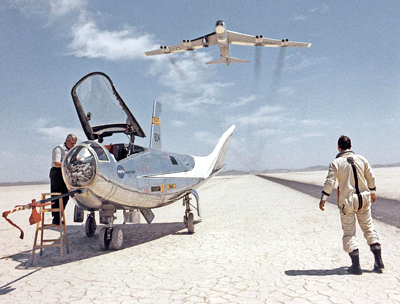
NASA
research pilot Bill Dana watches as NASA's NB-52B
flys overhead after a research flight in the HL-10.
On the left, John Reeves can be seen at the cockpit
of the HL-10.
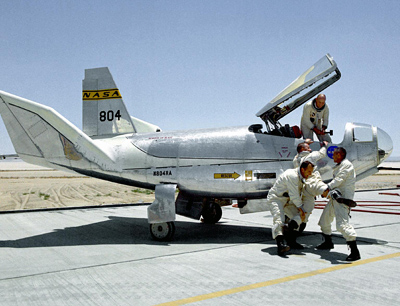
Showing
that not every moment of a test pilots life needs
to be serious, NASA pilots Bill Dana (left) and
John A. Manke try to drag Air Force test pilot
Peter Hoag away from the HL-10 lifting body while
Air Force Major Jerauld R. Gentry helps from the
cockpit.
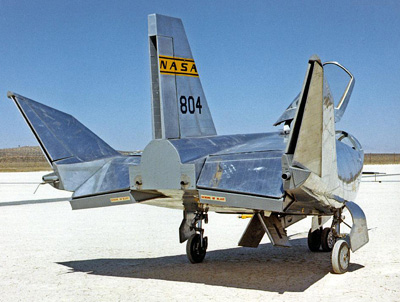
Northrop
HL-10 rear view showing the various control surfaces
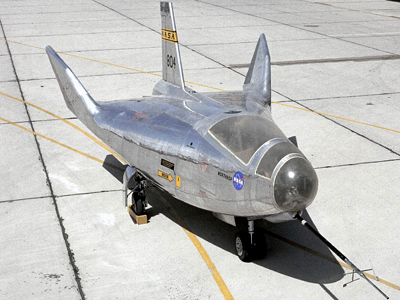
Northrop
HL-10 parked on the ramp at NASA's Flight Research
Center in 1966
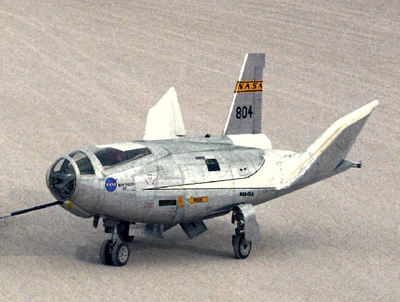
NorthropHL-10
on lakebed
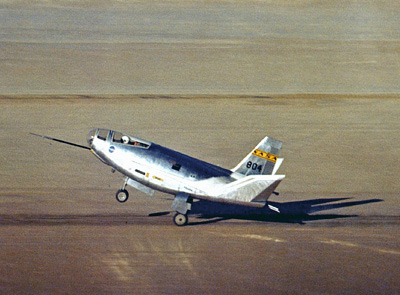
Northrop
HL-10 landing
|
|
The HL-10 was a peculiar research aircraft built by the
Northrop Corporation for NASA in 1966. "HL"
stands for horizontal landing, and "10" refers
to the tenth design studied by engineers at NASA's Langley
Research Center in Hampton, Virginia.
The HL-10 was one of five heavyweight lifting-body designs
flown at NASA's Flight Research Center (FRC - later Dryden
Flight Research Center), Edwards, California, from July
1966 to November 1975 to study and validate the concept
of safely maneuvering and landing a low lift-over-drag
vehicle designed for reentry from space. The vehicle essentially
had no wings and generated very little lift compared to
a regular aircraft. What lift there was came about due
to the overall shape of the body.
The HL-10 could not takeoff under its own power. Instead
it was dropped from a B-52 mothership. After a series
of 11 initial glide tests, the first powered flight occurred
on October 23rd, 1968, the HL-10 used the same basic XLR-11
rocket engine that powered the original X-1s. A total
of five powered flights were made before the HL-10 first
flew supersonically on May 9, 1969, with John Manke in
the pilot's seat.
The unusual shape of the aircraft, as well as the difficulties
in performing comparatively low-speed landings, required
a complex set of control surfaces. The rudders also served
as speed brakes, allowing the pilot to adjust his speed
during descent. Moving the flaps at the rear of the fuselage
in the same direction pitched the nose up, while moving
them in opposite directions rolled the vehicle to the
right or left. After the first flights, the HL-10's fins
were modified to improve its handling qualities. Once
these changes were made the HL-10 displayed the best handling
characteristics of the original heavyweight lifting body
aircraft.
The HL-10 was flown 37 times during the lifting body research
program and logged the highest altitude and fastest speed
in the Lifting Body program. On Feb. 18, 1970, Air Force
test pilot Peter Hoag piloted the HL-10 to Mach 1.86 (1,228
mph). Nine days later, NASA pilot Bill Dana flew the vehicle
to 90,030 feet, which became the highest altitude reached
in the program.
The four principal HL-10 pilots were Air Force Major Jerauld
R. Gentry, Air Force test pilot Peter Hoag, and NASA pilots
John A. Manke and Bill Dana.
Thanks to the lessons learnt through the HL-10 and the
Lifting Body program, NASA engineers had some points of
reference when it came to designing the Space Shuttle
and figuring out how to make a safe landing with an unpowered
aircraft with relativley poor aerodynamic qualities.
Similar and related vehicles:
 Martin Marietta X-24A
Martin Marietta X-24A
 Avrocar
Avrocar
 NASA AD-1
NASA AD-1
 Leduc Ramjet
Leduc Ramjet
 Northrop N-9M
Northrop N-9M
 Rockwell XFV-12A
Rockwell XFV-12A
|
|

